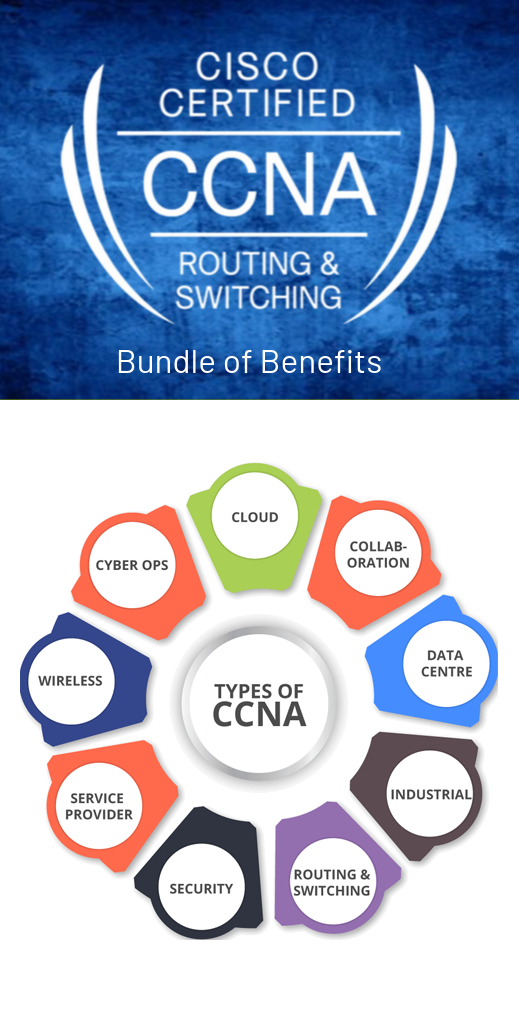CCNA Certificate
Cisco training offered by Dixitglobaltech is a networking course which is a must for a data networking career. The certificate from our institution will speak about your skills, deeper knowledge of the subject and your ability to handle network and communication products from Cisco Systems. The module is designed in terms of level, which is Entry, Associate, Professional, Expert and Architect.
Who should do Cisco Training and Certification Courses ?
- Network Engineers
- Network Administrators
- Network Support Technician
- Help Desk Technician
- Solution Architects
Levels of Cisco Certifications
- Entry
- Associate
- Professional
- Expert
- Architect
With this level of certification, the trainees get to choose several paths to choose the certification that suits your career or industry.
- Service Provider – the course is designed for professionals who work in infrastructure and Access solutions in a CISCO environment.
- Storage Networking – targeted at individuals who wish to implement Storage solutions over extended networks.
- Voice – it is applicable for professionals who plan to install and maintain voice over IP networks.
- Design – the training is aimed for professionals who are involved in designing CISCO networks with LAN and WAN routers.
- Routing and Switching – designed for networking professionals and provides expertise in installing and supporting Cisco networks containing LAN and WAN routers and switches.
- Wireless – expertise in designing and implementing secure cisco networks
- Service Provider Operations – designed for individuals who wish to manage, maintain and troubleshoot complex service provider network
Cisco CCNA
- Compare and contrast 051 and TCP/IP models
- Compare and contrast TCP and UDP protocol
- Describe the impact of infrastructure components in an enterprise network
- The effects of cloud resources on enterprise network architecture
- Compare and contrast collapsed core and three-tier architectures
- Compare and contrast network topologies
- The appropriate cabling type based on implementation requirements
- Configure, verify, and troubleshoot IPv4 addressing and subnetting
- Compare and contrast IPv4 address types
- The need for private IPv4 addressing
- Identify the appropriate lPv6 addressing scheme to satisfy addressing requirements in a LAN/WAN environment
- Configure, verify, and troubleshoot IPv6 addressing
- Configure and verify IPv6 Stateless Address Auto Configuration
- Compare and contrast IPV6 address types
Routing Technologies
- Describe the routing concepts
- Interpret the components of a routing table
- Describe how a routing table is populated by different routing information sources
- Configure, verify, and troubleshoot inter-VLAN routing
- Compare and contrast static routing and dynamic routing
- Compare and contrast distance vector and link state routing protocols
- Compare and contrast interior and exterior routing protocols
- Configure, verify, and troubleshoot IPv4 and IPv6 static routing
- Configure, verify, and troubleshoot single area and multi-area
- OSPFv2 for IPv4 (excluding authentication, filtering, manual summarization, redistribution, stub, virtual-link, and LSAs)
- Configure, verify, and troubleshoot single area and multi-area
- OSPFv3 for lPv6 (excluding authentication, filtering, manual summarization, redistribution, stub, virtual-link, and LSAs)
- Configure, verify, and troubleshoot EIGRP for lPv4 (excluding authentication, filtering, manual summarization, redistribution, stub)
- Configure, verify, and troubleshoot EIGRP for lPv6 (excluding authentication, filtering, manual summarization, redistribution, stub)
- Configure, verify, and troubleshoot RIPv2 for IPv4 (excluding authentication, filtering, manual summarization, redistribution)
- Troubleshoot basic Layer 3 end-to-end connectivity issues
Infrastructure Security
- Configure, verify, and troubleshoot port security
- Describe common access layer threat mitigation techniques
- Configure, verify, and troubleshoot lPv4 and IPv6 access list for traffic filtering
- Verify ACIs using the APICEM Path Trace ACI Analysis tool
- Configure, verify, and troubleshoot basic device hardening
- Describe device security using AAA with TACACS+ and RADIUS
LAN Switching Technologies
- Describe and verify switching concepts
- Interpret Ethernet frame format
- Troubleshoot interface and cable issues (collisions, errors, duplex, speed)
- Configure, verify, and troubleshoot VLANs (normal/extended range) spanning multiple switches
- Configure, verify, and troubleshoot inters witch connectivity
- Configure, verify, and troubleshoot STP protocols
- Continue re, verity arid troubleshoot STP related optional features
- Configure and verify Layer 2 protocols
- Configure, verify, and troubleshoot (Layer2/Layer3) Ether Channel
- Describe the benefits of switch stacking and chassis aggregation
WAN Technologies
- Configure and verify PPP and MLPPP on WAN interfaces using local authentication
- Configure, verify, and troubleshoot PPPoE client-side interfaces using local authentication
- Configure, verify, and troubleshoot GRE tunnel connectivity
- Describe WAN topology options
- Describe WAN access connectivity options
- Configure and verify single-homed branch connectivity using eBGP lPv4 (limited to peering and route advertisement using Network command only)
- Describe basic QoS concepts
Infrastructure Services
- Describe DNS lookup operation
- Troubleshoot client connectivity issues involving DNS
- Configure and verify DHCP on a router (excluding static reservations)
- Troubleshoot client- and router-based DHCP connectivity issues
- Configure, verify, and troubleshoot basic HSRP
- Configure, verify, and troubleshoot inside source NAT
- Configure and verify NTP operating in a client/server mode
Infrastructure Management
- Configure and verify device-monitoring protocols
- Troubleshoot network connectivity issues using ICMP echo-based IP SLA
- Configure and verify device management
- Configure and verify initial device configuration
- Perform device maintenance
- Use Cisco lOS tools to troubleshoot and resolve problems
- Describe network programmability in enterprise network architecture
We Provide Development Services To The Major Industries

Health & Fitness

Logistics

Education

Banking & Finance

Travel

Event & Sports

Hotels

Entertainment




